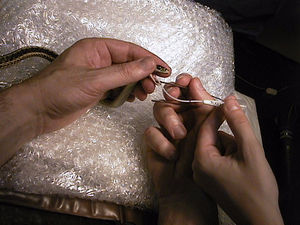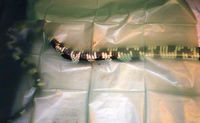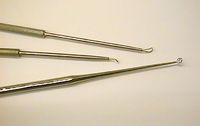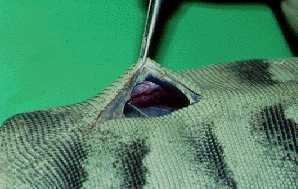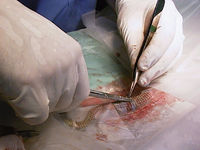Difference between revisions of "Lizard and Snake Surgery"
| Line 1: | Line 1: | ||
{{review}} | {{review}} | ||
[[Image:Snake_op.jpg|300px|thumb|right|(Copyright © RVC)]] | [[Image:Snake_op.jpg|300px|thumb|right|(Copyright © RVC)]] | ||
| − | ==Introduction | + | ==Introduction== |
Reptilian surgery has much in common with mammalian surgery with some special considerations. | Reptilian surgery has much in common with mammalian surgery with some special considerations. | ||
* For information on lizard and snake anaesthesia, see [[Lizard and Snake Anaesthesia|Lizard and Snake Anaesthesia]]. | * For information on lizard and snake anaesthesia, see [[Lizard and Snake Anaesthesia|Lizard and Snake Anaesthesia]]. | ||
Revision as of 20:01, 12 August 2010
| This article has been peer reviewed but is awaiting expert review. If you would like to help with this, please see more information about expert reviewing. |
Introduction
Reptilian surgery has much in common with mammalian surgery with some special considerations.
- For information on lizard and snake anaesthesia, see Lizard and Snake Anaesthesia.
- For information on lizard and snake dystocia surgery, see Lizard and Snake Dystocia.
- For information on how to inject a lizard, see Lizard Injection.
Preparation
- Assess hydration, metabolic and nutritional status and correct as necessary. Ideally take a blood sample. Use aseptic technique.
- Consider the administration of preoperative antibiotics if intraoperative contamination is possible
- Position by tapes and perform a thorough skin preparation.
- Consider that the ambient temperature of the operating room is within the animal’s POTZ.
- Position by ties or tapes. Perform a thorough skin preparation by scrubbing the skin gently with a soft brush for at least one minute. Clear drapes are preferable to cotton drapes since it is still possible to see the patient under them. Sterile adhesives sprays may be useful but do not use towel clips.
Surgical instruments
Instruments are similar to those used in mammalian surgery:
- Magnification (useful in small snakes and lizards)
- Radiosurgery may be helpful to control haemorrhageing
- Haemoclips are very useful for ligating vessels
- Dental curettes and cerumen loops are very useful for removing abscesses
- Eyelid retractors may be useful as abdominal retractors
- Sterile cotton-tipped applicators are especially helpful for swabbing small areas
Suture material
Reptiles may lack proteolytic enzymes that are involved in suture material degradation, therefore don’t use catgut. Materials that are absorbed by hydrolysis are preferable. The use of attached atramautic needles will decrease tissue trauma.
Coeliotomy approach
Common indications for coeliotomies include dystocia and related problems, abscesses and exploratory surgery especially for taking biopsies. Consider magnification for small snakes and lizards.
Lizards
- Paralumbar and midline approaches are recommended.
- Serious haemorrhage can occur if the ventral abdominal vein (which is very large and located on the ventral midline a few millimetres deep to the linea alba) is cut. A paramedian incision is recommended to avoid this. If a ventral midline approach is used great caution is advised!
Snakes
- The coeliotomy incision is usually made lateral to the ventral scales between the first two rows of lateral scales (between the scales rather than through them). This will allow eversion of the skin without any distortion when suturing. There are three layers to incise – skin, muscle and pleuroperitoneum. When closing, muscle and pleuroperitoneum can be sutured together.
Abcesses - Abscesses should be dissected out and removed in total, unlike cats or dogs where a simple drain may suffice. The wound is flushed with a diluted antiseptic such as chlorhexidene. After extraction the skin is sutured for primary healing or left open to heal by secondary intention.
Wound healing
- Surgical incisions in reptiles undergo the same phases of healing as mammalian wounds but strengthen much more slowly. Factors affecting wound healing include would include ambient temperature (i.e. POTZ), hygiene, orientation (longitudinal wounds heal more quickly). Leave sutures in for at least three to six weeks.
- Absorption of buried sutures appears prolonged because reptiles may lack proteolytic enzymes. Do not use catgut.
- Skin incisions tend to invert so use an everting suture pattern. Do not use continuous suture pattern in areas of stress (e.g. horizontal mattress, staples).
- Warn owners that shed skin may adhere in the areas of the healed surgical wounds for several sheds postoperatively. This can be gently removed.
Post-operative care
- Use a warm post-operative environment.
- Doxapram hydrochloride is an effective respiratory stimulant and can be used in apnoeic lizards (hypercapnia rather than hypoxaemia drives respiration in reptiles).
- Give fluids to maintain hydration.
- Once awake and responsive place in a warm, dark, quiet environment.
